Building a starship takes us along an evolutionary path as we master the myriad methods of its creation. And the process does not start at some arbitrary point in the future. Rather, it begins now as we put today’s technologies to work in the service of new concepts. Living ‘meta-technologies’ offer a way into the enclosed but verdant spaces of a worldship. In the essay below, Centauri Dreams regular Rachel Armstrong looks at current projects that explore the kind of biospheres a worldship will entail, and discusses enriched ecosystems that form ‘a new kind of Nature.’ Dr. Armstrong is co-director of AVATAR (Advanced Virtual and Technological Architectural Research) in Architecture & Synthetic Biology at the University of Greenwich, London. She completed clinical training at the John Radcliffe Medical School at Oxford in 1991, and in 2009 began PhD work in chemistry and architecture at University College London.
by Rachel Armstrong

“Why are you crying grandma?”
“I’m not!” The old woman quickly rubbed the back of her hand over a thin gleaming trail on her cheek. “There’s a lot of dust in the air thrown up by those sky hooks! They’re on the move again!”
Several teams of construction workers were using hover diggers to loosen the foundations of what looked like a small hill. They chopped into the humus like a pack of dogs looking for bones, levering sections of earth upwards before finding a new soil horizon to work on. Gradually, they started to expose a porous rock-like framework that was heavily covered with vegetation and subterranean organic matter.
“Where are they taking the Green Hollow now?” asked the child, as troupes of day-glow labourers swung by safety threads from the steel grabber that was making clumsy pinching movements above them.
The afternoon sun was making it difficult to see the details of the architecture, which was rising like a great shadow over the landscape. It no longer appeared green but black, except for where chemically sculptured nurturing light tracks passed through it.
“Up to Persephone, way beyond Earth’s orbit,” replied the old woman. “They’ve been growing the organs for that worldship interior for as long as I can remember. When I was your age, I even remember helping the boiler-suited workers plant the solutions by hand that would form her bones and tissues in the ground beneath us now. They told me that if I looked after them and kept them well fed with scraps of organic matter, then the Green Hollow would grow up big and strong.”
“Like feeding ducks?” asked the child.
The old woman nodded. “Yes, but you have to sow the duck seed to grow the birds first – then feed them!”
…………………………………………
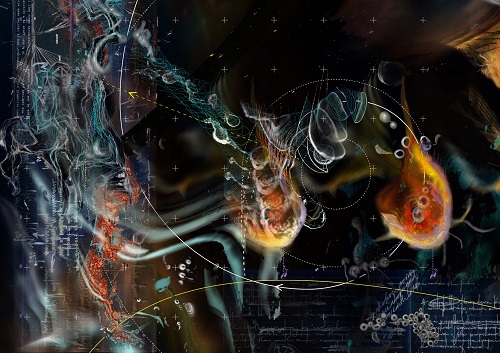
Image: This and other artwork in this essay by Elizabeth Anne Williams.
If we are unable to live ‘sustainably’ on a life-bearing planet – then how do we propose to live amongst the stars, or construct environments so they may become fertile – such as worldships?
At the start of the third millennium we are entering the next stage of human expansion. The scale and speed of our development, with the global spread of industrial processes, is catalyzing a new stage of metabolic evolution for R. Buckminster Fuller’s readymade ‘spaceship earth’ [1]. Yet, the industrial processes that support our growth are collectively ‘reverse terraforming’ our native life support system, such as by releasing stored carbon dioxide from fossil fuels on geological scales [2]. While James Lovelock and Lynn Marguils observed that Earth’s biosphere is a self-regulating system [3], its ability to respond to challenges operates within definable limits and the pressure of human development appears to currently be exceeding the homeostatic capabilities of our planetary system. Specifically, after 150 years of industrialization, our natural systems are being drained to feed our rapidly expanding urban populations with life-sustaining water, fertile soils and minerals [4]. Indeed, owing to the fundamental nature of these infrastructures, space engineering and architecture converge on the shared challenges in designing our life-support systems – which are centred on the issue of ‘sustainability’.
Sustainable development is a relatively new concept that has been emphasized by an awareness of resource constraints in the late 20th century. It invites questions about how current generations can meet their own needs as well as securing the welfare of future generations. Yet, the 1987 Brundtland Report [5] uses general terms to describe the nature of ‘sustainable’ development – as enabling the current generation to meet its own needs without compromising the ability of future generations to provide for themselves. This has precipitated a variety of different approaches to achieve these aims in the practice of the built environment ranging from the biological metaphors of biomimicry, to the decoration of our living spaces with elements from rural vistas in green roofs and walls.

Some methods incorporate the conservation of materials or resources, while others explore a variety of ways to improve the mechanical efficiency of systems. So, when considering a long-term pathway for establishing models of sustainable development, it is worth remembering that the concepts and practices that form ‘sustainable’ narratives are still very much in evolution.
Yet, the prevalent paradigm of sustainability operates according to the principles of resource conservation and operates as a ‘better’ kind of industrialization. In the absence of approaches that directly enrich our ecosystems, we are compromising the ability of generations to provide for themselves. Indeed, only a very few systems have been designed that can support sustained living in resource constrained environments. These ‘biospheres’ are technologically constructed, closed and controlled experiments, which propose to help us manage the Earth’s resources better. Potentially they enable us to establish ecosystems beyond the Earth’s surface and include projects such as BIOS-3 [6] and Biosphere 2 [7]. The price of these constructed environments helps append a monetary value to the services provided by natural ecosystems. For example, the International Space Station, which may be regarded as a biosphere that is regularly topped up with fresh resources, has cost between $100-150 billion [8] and during the Biosphere 2 project $9,000,000 was spent on each crew member per year [9].
Yet, such valuations cannot convey the investment made by Earth’s systems in producing a life-bearing planet. These have been made over billions of years through processes that we do not fully understand. The outcome of these natural systems is a range of priceless technologies that are formed from the integration of natural forces, which transform one set of substances into another through the process of metabolism and include soils, forests and crude oil [10]. Recently, we have been able to manipulate living systems at such small scales and with such precision that we are starting to understand how we may apply living processes as a kind of 21st century technology in ways that reinforce the actions of natural systems. By developing this new toolset potentially, in the longer term, human development may be synonymous with an increase in planetary fertility.
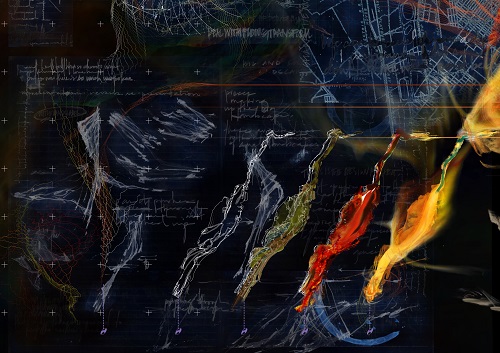
‘Ecopoiesis’ is the science that studies the transformation of inert terrains such as the Martian surface into life-bearing ones [11].To facilitate the production of life-promoting systems, these principles could also be applied to other lifeless terrains, such as metallic starship interiors, or the concrete surfaces of cities.
Indeed, life-enhancing habitats are a fundamental requirement for architectural projects in resource-constrained environments, and many principles can be explored on Earth’s surface without incurring the costs and extra degrees of technological difficulty associated with building non-terrestrial habitats. Indeed, an experimental approach to the design of buildings to increase environmental fertility and promote new ways of thinking about closed ecological systems could be developed by multi-disciplinary teams of researchers where multiple stakeholders – from space agencies, to property owners – may benefit from the construction challenges, ecological discoveries and post-occupancy evaluations in the pursuit of life-promoting architectures. While some novel materials with lifelike properties already exist as commercial products, such as Mycoform [12], which is a building material produced from compacted fungal mycelium, many innovations in bioprocessing are still prototypes. This presents a wealth of new opportunities for the exploration of new concepts in sustainability.
One such project is a collaboration between Astudio architects, Sustainable Now Technologies, AVATAR (Advanced Virtual And Technological Architectural Research) group at the University of Greenwich and the students at the Twickenham Academy in London, which applies an experimental algaeponics technology – the Greenstone Device – in an architectural context. This prototype cutting edge biotechnology system was designed specifically for the Twickenham Academy 6th form as a way of fixing 1 metric ton of carbon every 2.2. years. The facility provides students with access to state of the art, sustainable technology that forms the basis for unique project work that are integral to the 6th form curriculum. Students use the Greenstone Device to strudy the economics of carbon capture to the range of products generated by the technology.
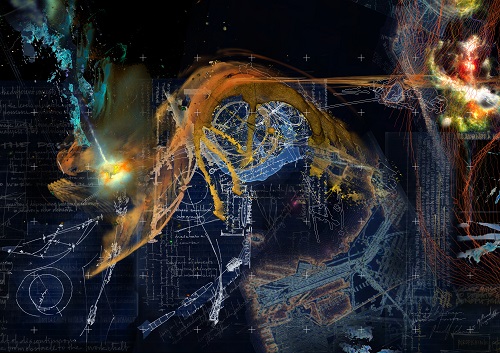
The questions raised by this integrated algaeponics project may be relevant to space programs – in the short and long term – that are investigating the possibilities of aqueous ecosystems in extra-terrestrial environments. For example, the European Space Agency’s MELISSA (Micro-Ecological Life Support Systems Alternative) project, seeks to produce food and reclaim minerals, water and oxygen through bioprocessing systems using waste matter such as, faeces, urea and carbon dioxide [13]. Extending the space research into terrestrial settings through a combined research program could expand our knowledge of constructing closed system ecologies and help develop next generation expertise in a new portfolio of materials, infrastructures, technologies and economic models. These may help us develop life-promoting habitats across a range of environments that span from the Earth to the stars.
Yet the impacts of possible new fusions and collaborations may also produce more immediate impacts on our urban living spaces, since lifelike technologies require similar kinds of infrastructures to fully alive systems. For example, bioprocesses require circulation of nutrient supplies through streams of air and water, which could take place within the walls of our homes [14]. Setting up non-equilibrium conditions within the fabric of our buildings enables them to be more than containers for living processes but to act as bioprocessing sites, which can perform a whole range of useful tasks that can be thought of as extended ‘organs’ to digest waste, recycle water, remove environmental toxins and even provide food for their inhabitants.
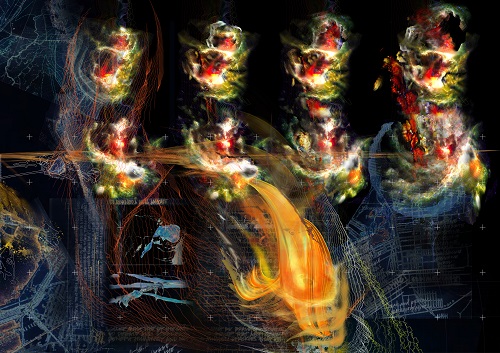
Moreover, lively building fabrics with metabolisms and physiologies do not need to be monstrous edifices. They could constitute a quiet revolution, which is locally produced and shaped by maker communities of bio hackers that are already developing experimental prototypes in their bedrooms, such as Cathal Garvey’s synthetic biology laboratory in Cork [15]. They may simply creep up quietly on our living spaces to infiltrate forgotten and under imagined spaces such as roofs, cavity walls and gaps under floorboards. Nor do they have to exist without aesthetic sensibilities. The Dutch electronics company Phillips proposes that our next generations of biochemical digesters will be so beautiful they will be on display in our homes. For example, bioluminescent bacteria may be housed in vials of beautiful hand-blown glass cells, which use waste that is generated in the average home to produce low-level, mood-elevating light [16].
Indeed, an immediate investment in developing the conceptual and technological infrastructures to produce life-promoting environments may have far reaching benefits in the long term – where buildings are sites for micro agricultures that produce rich, fertile fabrics, such as soils and coral reefs. In turn, these may provide a native infrastructure that possesses the richness and diversity that enrich existing ecosystems and could be considered to exist within a spectrum of natural processes as a new kind of Nature. Indeed, the mutually reinforcing approaches that exist at the intersection between space research and sustainable architecture, may help us better understand how to design, engineer and inhabit closed system ecologies through the design and prototyping of post natural fabrics, which could be prototyped within the everyday context of our swelling cities. For example, the opportunities for material fertility within micro sites may be enhanced by orchestrating the flow and transformation of matter through them in a large range of forms such as, synthetic soils grown from complex chemistries, entanglements of silicon circuitry and cell cultures, or green plants with bead-like metallic micro batteries.
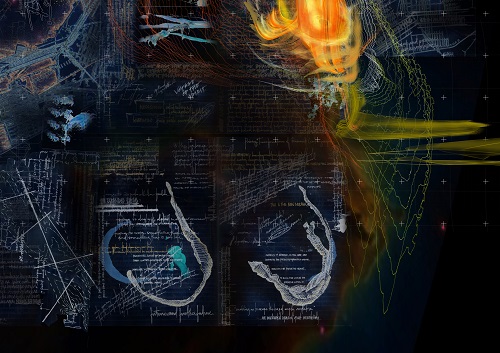
These heterogeneous fabrics may eat with us, breathe, age and feel alongside us. They may process our biochemistry as if they were our own native extended organs and embody aesthetic preferences that convey our desires and betray our emotions because they are woven through our own design. Indeed, the diversity and versatility of their configurations may not only help us increase the liveability of our surroundings and establish fundamental principles for the construction of synthetic ecosystems in every conceivable environment but offer us new survival strategies that support this current wave of human expansion. Yet, we do not have to wait for starships to be realised before we conduct these ecological experiments. Rather we can create a liveable legacy for today’s sustainability challenges by changing our expectations of our cities, habitats and ecosystems to create new, evolvable foundations that weave together the territories between the Earth and stars through living toolsets.
The developments that take us beyond this planet do not need to be conducted within a vacuum. Indeed, it makes economic and scientific sense to prototype new ideas within the resource-challenged sites of our current cities, where our learning can be extended across generations of architects, engineers and scientific researchers. The outcomes of these explorations will inform the construction principles, substrates and technologies necessary for the development of habitable worldship interiors and the principles that will enable us to transform barren environments into ones that can support new kinds of life. Indeed, weaving starship fabrics into our cities will enable us to seed life throughout the cosmos, long before the first colonies ever leave our home planet.

…………………………………………
“It’s scary!” remarked the child, gripping his grandmother’s hand.
“I suppose so.” Mused the old woman, noting how the striking absence of life made the gaping hole where the Green Hollow had once been seem particularly ominous. “But, they’ll start to fill it with duck seed soon!” She smiled reassuringly.
Two skyhooks appeared to walk like giants towards them, rocking in their seven league boots above the horizon. Both grips were clutching tankers of fluid. The day-glow crews moved like spiders on threads between them, guiding and cajoling the monsters until they towered over the cavity in the ground.
An all-terrain-vehicle drove up to the bystanders and an official wearing a peaked olive green cap barked at them to stand back and mind the spray when the tanker contents were discharged into the quarry. He handed them some porous paper face masks, which made everyone look like chickens.
“Planting a new structure was a much simpler operation when I was young!” remarked the grandmother under her paper beak, as the boy wondered what kinds of adventures he might have in a hard peaked hat.
Several long, thin-legged walkers braved the rich spray as the tanker contents were discharged. They deftly folded several layers of a football-pitch sized membrane into the rapidly filling hole that was impregnated with bacterial spores. As the waters rose, the walkers’ legs retracted and became cantilevers that braced their bodies in a flotation formation. They continued to knit and tuck the membranes into the fluid as they also seeded and folded hardy microorganisms in the muddy eddy of the uterine pit. Yet, unlike the lifeless scar left by the quarry, the goo itself was vibrant, feeding and evolving. Even within the first minutes of its existence, strange tubular embryonic forms were starting to yaw, roll and involute like a rising cake mix. By the time the walkers stretched their legs again, the contents of the pit had set like a gel and small birds were nervously landing on its trembling surface, gorging on eluted earthworms.
“Is all the seed in the hole now?” asked the boy.
“I think so,” replied his grandmother as the official swung his arm low, motioning to the public that they could remove their face shields.
“So, what happens now?”
“We wait,” she said.
——-
References
[1] Fuller, R.B. 2008. Operating manual for spaceship earth, Zürich: Lars Muller Publishers.
[2] US National Research Council. 2010. Advancing the science of climate change, America’s climate choices. Washington: National Academies Press. [online] Available at: [Accessed 18 April 2013]. p3.
[3] Lovelock, J. 2000. Gaia: A new look at life on earth, Oxford: Oxford Paperbacks.
[4] Lovelock, J. 2009. The vanishing face of Gaia, New York: Basic Books.
[5] World Commission on Environment and Development.1987. Our common future. Report of the World Commission on environment and development. Published as Annex to General Assembly document A/42/427. Available at: http://www.un-documents.net/our-common- future.pdf. [Accessed 25 April 2013].
[6] Prado, M.E. 1983-2003. Russian CELSS Studies. [online] Available at: http://www.permanent.com/russian-celss.html. [Accessed 22 December 2014].
[7] Avise, J.C. 1994. The real message from Biosphere 2, Conservation Biology, 8(2) pp. 327-329.
[8] European Space Agency. No date. How much does it cost? International Space Station? Human Spaceflight. [online] Available at: http://www.esa.int/Our_Activities/Human_Spaceflight/International_Space_Station/
How_much_does_it_cost. [Accessed 22 December 2013].
[9] Avise, J.C. 1994. The real message from Biosphere 2. Conservation biology, 8(2), p. 327-329. See also Keim, B. 20 April 2009. Biosphere 2 not such a bust. Wired. [online] Available at: http://www.wired.com/wiredscience/2009/04/biospheresci/. Available 26 December 2013].
[10] I am applying the term ‘technology’ to refer to a total cosmic infrastructure of artificial and natural forces that may be harnessed to perform useful work. Heidegger, M. 1978. Being and Time, New Ed. Oxford: Wiley-Blackwell.
[11] Fogg, M.J., “Dynamics of a Terraformed Martian Biosphere,” Journal of the British Interplanetary Society, 46, 293-304 (1993).
[12] Mycoform. No date. Terreform. [online] Available at: http://www.planetaryone.com. [Accessed 27 December 2013].
[13] MELISSA. 8 February 2006. Advanced Life Support, European Space Agency. [online] Available at: http://ecls.esa.int/ecls/?p=melissa. [Accessed 27 December 2013].
[14] This possibility was discussed earlier in a piece on Living Technology.
[15] Regalada, A. 14 February 2012. Doing biotech in my bedroom. MIT Review. Available at: http://www.technologyreview.com/news/426885/doing-biotech-in-my-bedroom/. [Accessed 27 December 2013].
[16] Muppala, S.C. 1 December 2011. Glowing Bioluminescent Bacteria Brings Hope of a New Power-efficient Lighting System. Medindia [online] Available at: http://www.medindia.net/news/Glowing-Bioluminescent-Bacteria-Brings-Hope-of-a-New-Power-efficient-Lighting-System-94186-1.htm#ixzz2etJ33aFN. [Accessed 12 September 2013].



Another enjoyable article by Dr. Armstrong. Chocker-block full of creativity based on sound science once again!
Reading one of Dr. Armstrong’s articles recently on the starship project, I had wondered then if we might send seeds first as opposed to humans and what Dr. Armstrong has written here suggests that is maybe what could happen.
So full of ideas as usual and also I love the format of the article being contained within a short story! Nobody else does that and is something I love about Dr. Armstrong’s writing. I am sure most will agree.
It’s a great and above all sustainable vision, and we have done so little to date to explore the space. Biosphere experiments appear to have been almost complete disasters. But the principle of a closed organic system is clearly possible – just look around. When we assume the role of symbiotic micro-organisms in a larger organism, we are actually following a tried and true paradigm. Nature has been doing this for a very long time, so we should be able to figure this out.
When we look at a typical bay on the ISS, we see racks of equipment bristling with controls and wires and knobs. With virtual 2D and 3D interfaces, all of this can in principle be virtualised. So on an organic spaceship, control panels do not dictate the form, because the desired control functionality may be made wholly virtual. This allows great freedom of design. If control is decentralised in this way, there may not even be the requirement for a “bridge”.
I see no need to directly send living meat-bags to the stars … ever, when it would be far more efficient to simply send the relevant code to re-instantiate base or modified humans at the other end.
I would hope that when (probably not if) we start building artificial life for technological purposes, we have learned from our experiments of exotic species introductions in the past. One should also bear in mind that once living systems are introduced into our infrastructure, maintenance costs become an issue. Gardeners understand this, which is why there are so few beautiful and functional gardens, and gardening services are employed if just to keep lawns cut and invasive weeds controlled. If structures for living and working incorporate living systems, whether natural or synthetic, they will require maintenance by the owner or a service. Unless there are clear advantages, I do not see how they compete with our existing approach of using static, dead materials.
It might seem interesting for individual structures to process materials, but that may reflect the wrong scale. Just as multicellular animals have discrete organs to handle tasks for processing food and waste, our cities do the same, using roads and sewers to transport food and waster to specialty storage and processing structures. Specialization trumps self sufficiency.
Building fully sealed biospheres on earth does make a lot of sense for future space activities. Why there are so few experiments since interest started [970’s ?] surprises me. But I doubt that the science and technology spinoffs will have much relevance for living on Earth. I also suspect that some of the technologies developed, especially wrt synthetic organisms, should never be allowed use on Earth except under very controlled conditions.
Claire Booth Luce once said that a man may live inside his castle, but once inside, it’s his nursery….the artist says it all….looks like we’re inside realms of the womb….a womb meant to transport a civilization perhaps for millennia….
@Alex Tolley:
” One should also bear in mind that once living systems are introduced into our infrastructure, maintenance costs become an issue. Gardeners understand this, which is why there are so few beautiful and functional gardens, and gardening services are employed if just to keep lawns cut and invasive weeds controlled.”
Mr Tolley sir, how much does it cost to maintain the Amazon?
@Jamie
If you try transplanting some of it into the skyscrapers in NY, or Dubai – a lot. ;)
Interesting that you mention the skyscrapers in NY. There is a green roof movement underway in that city.
@David Cummings – I am aware of that, and I’m very much in favor of it. I am also aware that the idea is that one uses grasses and plants adapted to the NY climate and that they use “free environmental resources” as part of their system. They also require more maintenance than an asphalt roof. Biosphere 2 was an object lesson in the difficulties of ecosystem management in enclosed spaces, which is what we are talking about with worldships, whether being tested on Earth or traveling to Tau Ceti.
Yes, of course you are right. Growing specific plants adapted to the NY climate is one thing… transplanting the rain forest in NY quite another.
Colin Weaver February 15, 2014 at 8:46
I see no need to directly send living meat-bags to the stars … ever, when it would be far more efficient to simply send the relevant code to re-instantiate base or modified humans at the other end.
Apart from the many issues I have with this statement, the main one is that it assumes that we “just” want to spread for the sake of spreading.
If we were ever in a position to do as you say, a few extra mega-tonnage of “meat-bags” and associated paraphernalia would be a trivial burden.
Another issue is that surely we want to go there in person – in a generation, in a few generations or in stasis. There needs to be a continuity of the founding ideas for going somewhere. There should be time for evolution of that idea but to do as you say would require a cut from our end, in space and time, and at some time a few 100 or a 1000 years, a re-forming of that thought process by the assemble “meat-bags” and a continuity of an idea/strategy that might be defunct or abandoned. There is also no way to guarantee, using the method you describe, that the said assembled “meat-bags” at the other end will do as they were supposed to or indeed do anything. If you assume to “encode” programming into their make up then they will surely not be us anymore… but besides that, the level of tech involved to achieve that alone would suggest that we won’t need to be stingy on the tonnage we are sending.
The journey is surely as important as the destination – at least for humans as we are now.
I visit Centauri Dreams (which is a nice site in my opinion) when I see or hear that Dr. Armstrong has an article on here.
With that in mind, I think the one thing I think we can all agree upon is that Dr. Armstrong is a revolutionary thinker and true visonary! Am sure even her critics would agree with me on that!
And re one comment earlier above, I honestly believe that if we have got to the stage of sending ‘code’ then we will also have overcome the problems of sending humans.
People it is in my humble view, that we are witnessing history in the making with this lady.
Where I can see more art from Elizabeth Anne Williams?
Stars in their eyes: architects and scientists mull designs for ark in space
Keen to flee catastrophe? Icarus Interstellar may be able to help – but you’ll live in a mud pie in the sky and never return to Earth
The Guardian, Thursday 22 May 2014 13.55 EDT
The good news is you will fly into space on a mission to save humanity. The less good news is you will abandon the rest of Earth to certain doom and live in a mud burrow with only nerds for neighbours.
Such are the quandaries that passengers will face if plans work out for an interstellar spaceship designed to serve as a lifeboat for Earth should the planet face disaster in the next century.
Architects, designers and scientists have joined forces to explore the technologies needed to build a spacecraft that could be launched within the next 100 years and sustain human life for generations.
Early designs for the ship envisage a giant 15km-wide ball filled with soil that will support complex ecosystems of microbes, plants and animal life. Rather than building homes on top of the soil, humans will live within, carving out rooms in a network of connected burrows.
“We need to think how we might live in space long term,” said Rachel Armstrong, lead researcher on Project Persephone at of Greenwich University. “So far, our approach to space has been very top-down. We take a vessel, put an environment in it, and off we go. For generational starships we need a different approach.”
Full article here:
http://www.theguardian.com/science/2014/may/22/stars-in-their-eyes-architects-scientists-ponder-designs-ark-space